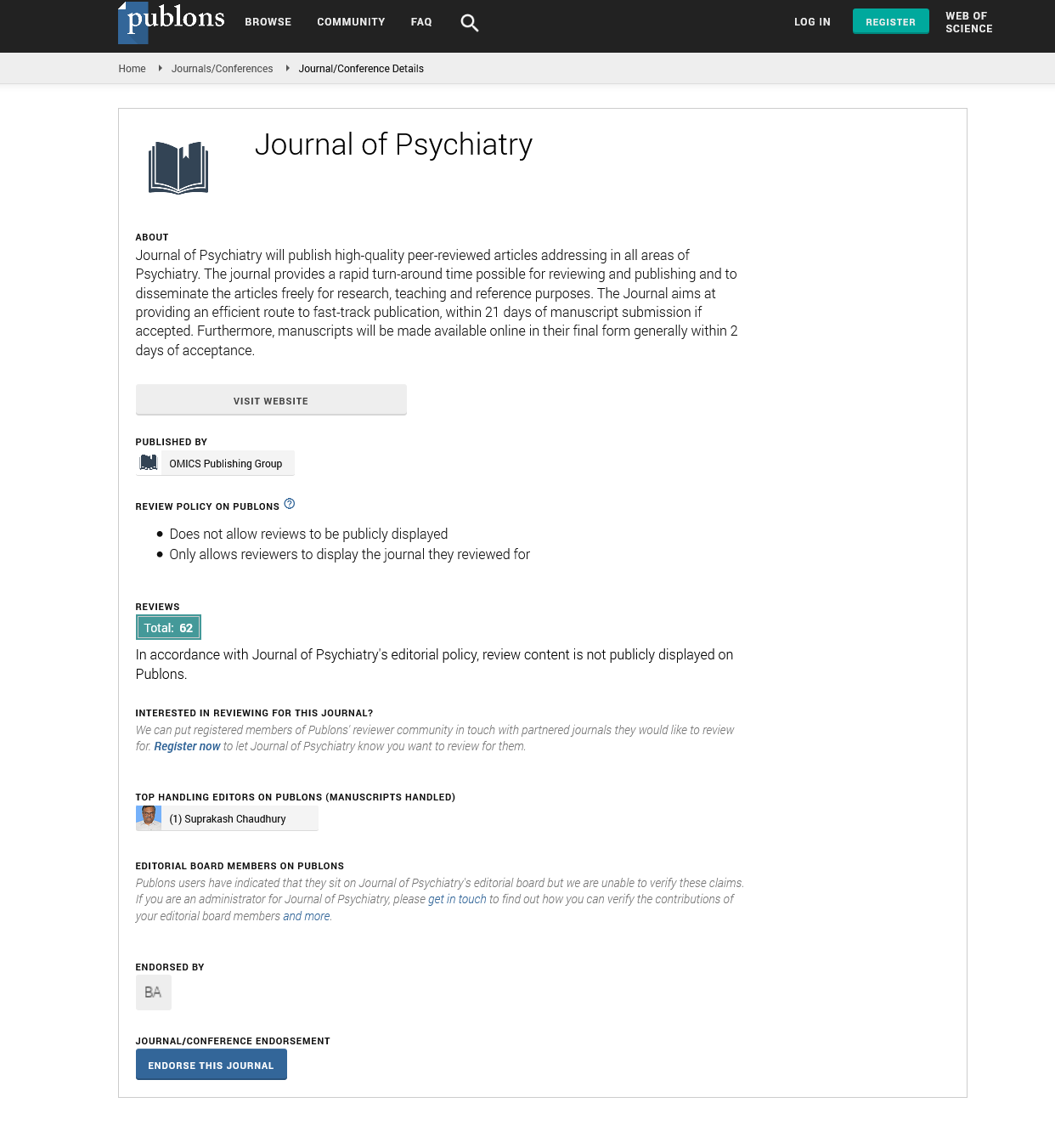Indexed In
- RefSeek
- Hamdard University
- EBSCO A-Z
- OCLC- WorldCat
- SWB online catalog
- Publons
- International committee of medical journals editors (ICMJE)
- Geneva Foundation for Medical Education and Research
Useful Links
Share This Page
Open Access Journals
- Agri and Aquaculture
- Biochemistry
- Bioinformatics & Systems Biology
- Business & Management
- Chemistry
- Clinical Sciences
- Engineering
- Food & Nutrition
- General Science
- Genetics & Molecular Biology
- Immunology & Microbiology
- Medical Sciences
- Neuroscience & Psychology
- Nursing & Health Care
- Pharmaceutical Sciences
Commentary - (2023) Volume 26, Issue 12
Dual Recovery Peer Support: A Collaborative Model for Psychological Outcomes
Erin Wallace*Received: 29-Nov-2023, Manuscript No. JOP-23-24441; Editor assigned: 01-Dec-2023, Pre QC No. JOP-23-24441 (PQ); Reviewed: 15-Dec-2023, QC No. JOP-23-24441; Revised: 22-Dec-2023, Manuscript No. JOP-23-24441 (R); Published: 29-Dec-2023, DOI: 10.35248/2378-5756.23.26.657
Description
In the current dominion of mental health and substance use disorders, the power of peer assistance has emerged as a transformative force, particularly in the context of dual recovery. Dual recovery, synonymous with co-occurring disorders, signifies the simultaneous presence of mental health and substance use challenges in an individual. the important role that peer support plays in enhancing the results of psychological treatment for dual recovery, emphasizing the special significance that people with lived experience play in encouraging resilience, optimism, and long-term recovery.
Understanding dual recovery
Dual recovery is a complex journey that demands a holistic and integrated approach. Individuals navigating both mental health and substance use disorders often face unique challenges that can complicate traditional treatment outcomes. Recognizing the interconnected nature of these issues is significant for designing effective interventions that address the multifaceted needs of those on the path to recovery.
Peer assistance, rooted in the principle of individuals with lived experience supporting others in similar situations, and has gained prominence as a valuable component of dual recovery. Peer support programs create a sense of community, understanding, and shared experience, offering a unique form of support that complements traditional psychological treatments.
Key components of peer assistance in dual recovery
• Peers, having walked a similar path of recovery, bring a depth of understanding and empathy that is unparalleled. This shared experience creates an immediate connection, fostering trust and openness in the therapeutic relationship.
• Individuals in dual recovery often grapple with feelings of despair and hopelessness. Peers serve as living proof that recovery is possible, instilling hope and inspiring a sense of possibility for those facing similar challenges.
• Peer assistance plays a pivotal role in dismantling the stigma surrounding mental health and substance use disorders. By openly sharing their stories, peers contribute to a culture of acceptance and understanding, creating an environment where individuals feel comfortable seeking help.
• Peers offer practical guidance based on their own experiences, helping individuals navigate the intricacies of dual recovery. This can include insights into coping strategies, relapse prevention techniques, and practical tips for managing the dayto- day challenges of recovery.
• Peer assistance is most effective when integrated seamlessly with traditional psychological treatments. This collaborative approach ensures that individuals receive a comprehensive and person-centered continuum of care. Integrating peer support within therapy sessions enhances the therapeutic alliance. Peers can share their experiences, provide emotional support, and offer insights that complement the clinical expertise of mental health professionals.
• Peer-led support groups create a space for individuals in dual recovery to connect, share, and learn from one another. These groups provide a sense of belonging and reinforce the understanding that individuals are not alone in their journey.
• Establishing mentorship programs where individuals further along in their recovery journey mentor those in the early stages enhances the sense of community and offers guidance from a perspective of shared experience.
• Research has shown that incorporating peer assistance into dual recovery programs significantly improves treatment outcomes. Studies indicate reduced rates of relapse, increased engagement in treatment, and enhanced overall well-being when peer support is integrated into the continuum of care.
Challenges and future directions
While the benefits of peer assistance in dual recovery are evident, challenges such as ensuring adequate training for peers, addressing potential boundary issues, and promoting inclusivity in peer support programs need continued attention. Additionally, on-going research is essential to refine and expand the evidence base for the effectiveness of peer assistance in diverse populations and treatment settings. In the achieving of improved outcomes in psychological treatment for dual recovery, peer assistance stands as a inspiration and resilience. By recognizing and harnessing the power of individuals with lived experience, we can create a more inclusive, supportive, and effective approach to dual recovery. As we continue to evolve our understanding of comprehensive treatment, the integration of peer assistance emerges as a foundation in the process towards sustainable and meaningful recovery for individuals facing the complexities of dual challenges.
Citation: Wallace E (2023) Dual Recovery Peer Support: A Collaborative Model for Psychological Outcomes. J Psychiatry. 26:657.
Copyright: © 2023 Wallace E. This is an open access article distributed under the terms of the Creative Commons Attribution License, which permits unrestricted use, distribution, and reproduction in any medium, provided the original author and source are credited.

